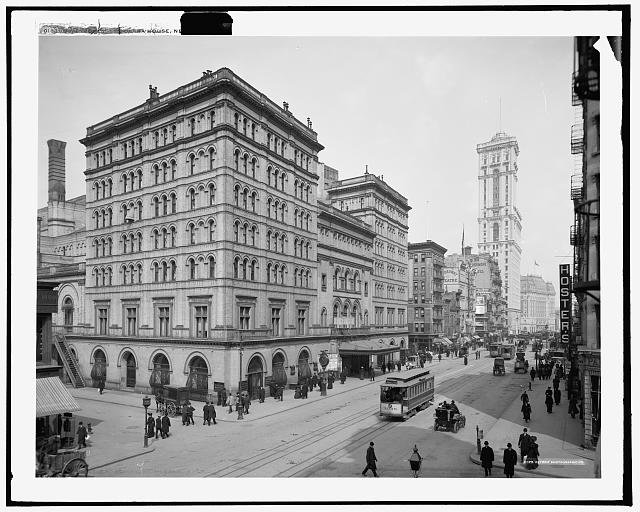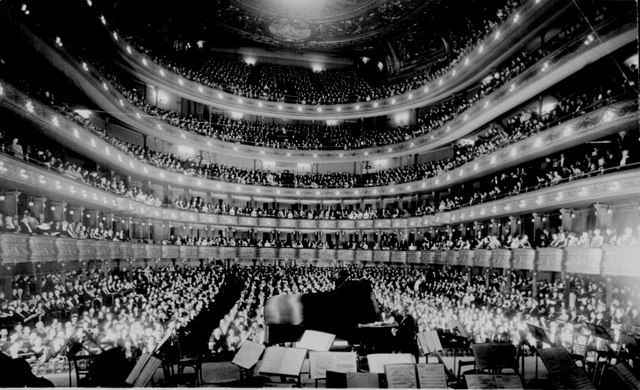Last Chance to Catch NYC's Holiday Notalgia Train
We met the voices of the NYC subway on our nostalgia ride this weekend!

 Source: Library of Congress
Source: Library of Congress
The Academy of Music (which was located at the corner of 14th Street and Irving Place) is considered to be the first successful opera house in New York City, though it has largely been forgotten. When it was constructed in 1854, the Academy of Music, which was located at the northern end of the city’s theater district, was a respectable place to go. However, by the early 1880s, the area had become the haunt of unionists and anarchists. Two different groups–New Yorkers unable to purchase boxes at the Academy because of its limited seating and patrons dissatisfied with the Academy’s location–decided it was time to build a new opera house. The influential group included W. H. Vanderbilt, W. K. Vanderbilt, Cornelius Vanderbilt, J. P. Morgan, and J. A. Roosevelt.
In their inaugural meeting, they decided that “the opera house would not be built below Thirtieth street nor above Fiftieth street and it would be between Fourth avenue and Seventh avenue” and that the “subscribing box holders [would] pay $1 admission at each performance.” They ultimately hired the architect Josiah Cleaveland Cady to design what would become the City’s preeminent opera house. The Metropolitan Opera House opened on October 22, 1883, with a performance of Charles Gounod’s Faust featuring Swedish soprano Christine Nilsson.
According to The Sun:
“The night on which the Metropolitan Opera House threw open its doors to the world is one that none who were present will be likely ever to forget. Indeed, as the years go by, and the house itself becomes one of the older landmarks, it will be all the more a matter of pride to many to be able to look back over the vista of time and to say, “I was present when the first note of music was heard in public at the opera house.”
The palazzo style building was located at 1411 Broadway at 39th Street, making it closer to the city’s emerging mansion district where most of the boxholders lived. In August 1892, after only nine years, a fire destroyed much of the opera house’s interior, forcing it to close until November 1893. Carrère and Hastings redesigned the interior in 1903, which was the last major renovation to occur until the 1940s.
 The Opera House in 1937, pre-renovation (Source: The National Archives)
The Opera House in 1937, pre-renovation (Source: The National Archives)
In the mid-1920s, Otto H. Kahn, the President of the Metropolitan Opera Company and Chairman of its Board of Directors, was driving force behind the plan to erect a new opera house further uptown. This new opera house would have a seating capacity of 4,000 (from 3,500), fewer boxes (which also would be leased and not bought), and it would be “a plain and dignified opera house, rather than an ornamental or monumental one.” Their definitions of “plain and dignified” are debatable since an official at the Opera Company stated that “[t]here is only one style of architecture that would do for a new Opera House in New York, and that is the modern New York Style [which entails] a skyscraper with towers and terraces in the revised Babylonian style.”
In 1927, Benjamin Wistar Morris (who designed the Cunard Building) was appointed architect and Joseph Urban (who designed the original Zigfield Theater) was named associate architect. They were tasked with designing the monumental new opera house, which would be located on 57th Street between Eighth and Ninth Avenues. This announcement caused a real estate boom in the area. However, not everyone was on board with the location and alternatives were researched as far north as 110th Street and 5th Avenue. By early 1928, the 57th Street plans were dropped. Luckily, we still have Urban’s plans for the proposed grandiose opera house.
Rockefeller Center was briefly considered as an alternative site since the land was to be leased from Columbia University until 1931. Ultimately, the depression put to rest to any other thoughts of moving the opera house.
The Old Met’s interior was beloved and its acoustics were generally considered to be great, though one acoustics expert told The New York Times that while “the acoustics of the present opera house are considered good as a whole, although somewhat freakish.” However, the backstage facilities did not provide sufficient room for the Opera Company to work. In the 1920s when a move to a larger space seemed inevitable, many New Yorkers were in opposition. Between the memories associated with the old building and the beauty of its interior, they were willing to do any they could to preserve the old building
In 1938, the opera house was threatened with demolition again, this time over one million dollars in gifts from the public saved it. Two years later, the not-for-profit Metropolitan Opera Association took over ownership of the opera house. The Association renovated the house’s interior converting the second tier boxes into standard row seating. This resulted in a seating capacity of 3,625 seats and left only the first tier of boxes remaining.
The 1960s saw the final threat to the opera house. John D. Rockefeller III, with help from Robert Moses, convinced the Metropolitan Opera to join the newly created Lincoln Center campus. Lincoln Center promised to provide the opera company with the larger stage, more spacious backstage, and better acoustics for which they had yearned for years.
The final performance at the old Met was held on the night of April 16, 1966, during which Conductor Leopold Stokowski addressed the audience from his podium stating, “I beg you to help save this magnificent house.” Stokowski pled with the audience because the Met had leased the property on which their current home was located to Keystone Associates, with the explicit requirement that the building be demolished. At the first meeting of the New York City Landmark Preservation Commission, the commissioners voted whether the Metropolitan Opera House should be landmarked. The building, and the people of New York, lost by a vote of six to five. The Commission caved in to pressure from the Met, which feared that a rival opera company would put them out of business. Leonard Bernstein, Marian Anderson, Tony Randall, Mayor John V. Lindsay, and even Governor Nelson A. Rockefeller attempted to save the house that Caruso built to no avail. The building, which was razed in 1967, was one of the greatest loses New York City has seen since the creation of the New York City Landmarks Preservation Commission. Today, the building is a corporate skyscraper which houses retail like Chase and Hallmark on the ground floor.
Subscribe to our newsletter